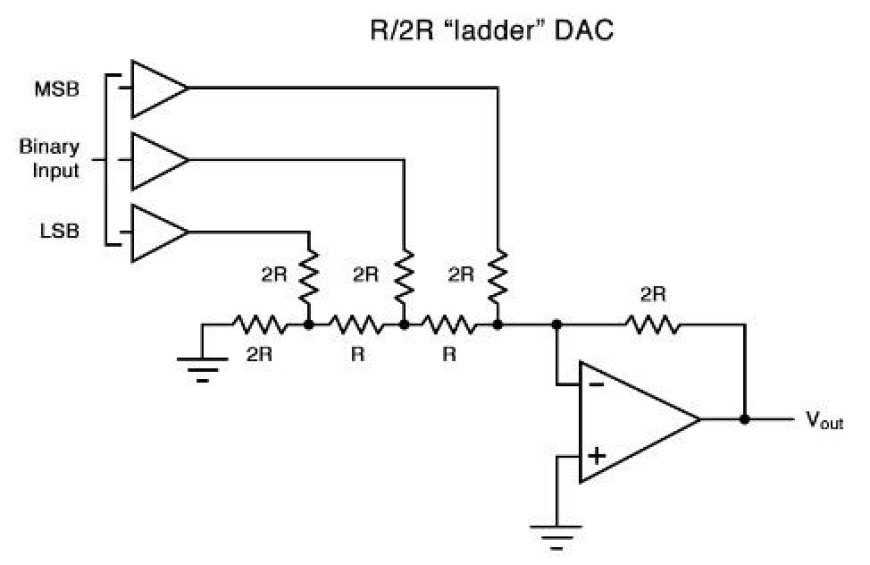R-2R LADDER DAC
R-2R Ladder DAC: Simple, cost-effective solution for converting digital signals to analog using just two resistor values.

R-2R Ladder DAC
- There are some problems with binary weighted resistor DACs that can be fixed with the R-2R Ladder DAC.
- A R-2R ladder network is used in the inverted adder circuit of an R-2R Ladder DAC to make an analog output that is very close to the digital (binary) input.
1. The Ladder Network
- A network of resistors set up like a ladder is at the heart of the circuit. Each "rung" has two resistors, one with resistance R and the other with resistance 2R.
- The way they're linked makes a unique design of resistances.
2. Digital Input
- You put a digital code into the circuit, such as 0111. Each bit controls a switch that is linked to a ladder rung.
- After a "1," the switch is closed and a reference voltage (Vref) is connected to that rung. If you press "0," the switch is open.
3. Current Flow
- When certain buttons are closed, the Vref meets different resistances. In turn, this makes different currents run through the ladder.
4. Op-Amp Magic
- An operational amplifier (op-amp) is like a very accurate voltage reader.
- It measures the total currents coming from the ladder and sends out a voltage that is proportional to the digital code that was put in.
Advantages of the R-2R Ladder DAC
- Simple and scalable: you only need two types of resistors (R and 2R), so it's easy to plan and build for any number of bits.
Accurate: Resistor matching is not as important as it is with binary-weighted DACs, so output voltages are more accurate.
Efficient: It can handle high-speed changes because it is simple and doesn't use much power.
Applications
- DACs, which turn digital audio into analog audio, are used in music players and sound systems.
- Test and measurement signal sources.
- ₧ Motor control methods that let you change the speed precisely
- Systems that take information from sensors and turn it into computer values
Key Points
- The R-2R ladder network, which sets up a specific pattern of resistances, is what makes the circuit work.
- Digital input manages switches that connect or separate Vref from the ladder.
- The currents from the ladder are turned into an equivalent electrical voltage by the op-amp.
R-2R DACs are easy to use, accurate, scalable, and efficient. - Don't forget that each bit in a binary number can only have one of two possible meanings. That is, either 0 or 1.
- Let the 3-bit binary input be b2b1b0, which means 2⋽1⋽0. Bit b2 = 2 stands for the Most Significant Bit (MSB) and Bit b0 = 0 stands for the Least Significant bit (LSB).
- The digital switches in the picture above will be linked to ground when the bits that go with them are set to "0."
- In the same way, the digital switches in the picture above will be linked to the negative reference voltage (VR-−) when the associated input bits are set to 1.
- Finding the generalized output voltage equation of an R-2R ladder DAC is not easy. But it's easy to find the analog output voltage values of the R-2R Ladder DAC for each pair of binary inputs.
- Here are some of the benefits of an R-2R Ladder DAC:
- The R-2R Ladder DAC only has two types of resistors: R and 2R. It is easy to choose and make resistors that work better.
- If the digital input has more bits than expected, we need to add the necessary number of R-2R parts.
What's Your Reaction?



































